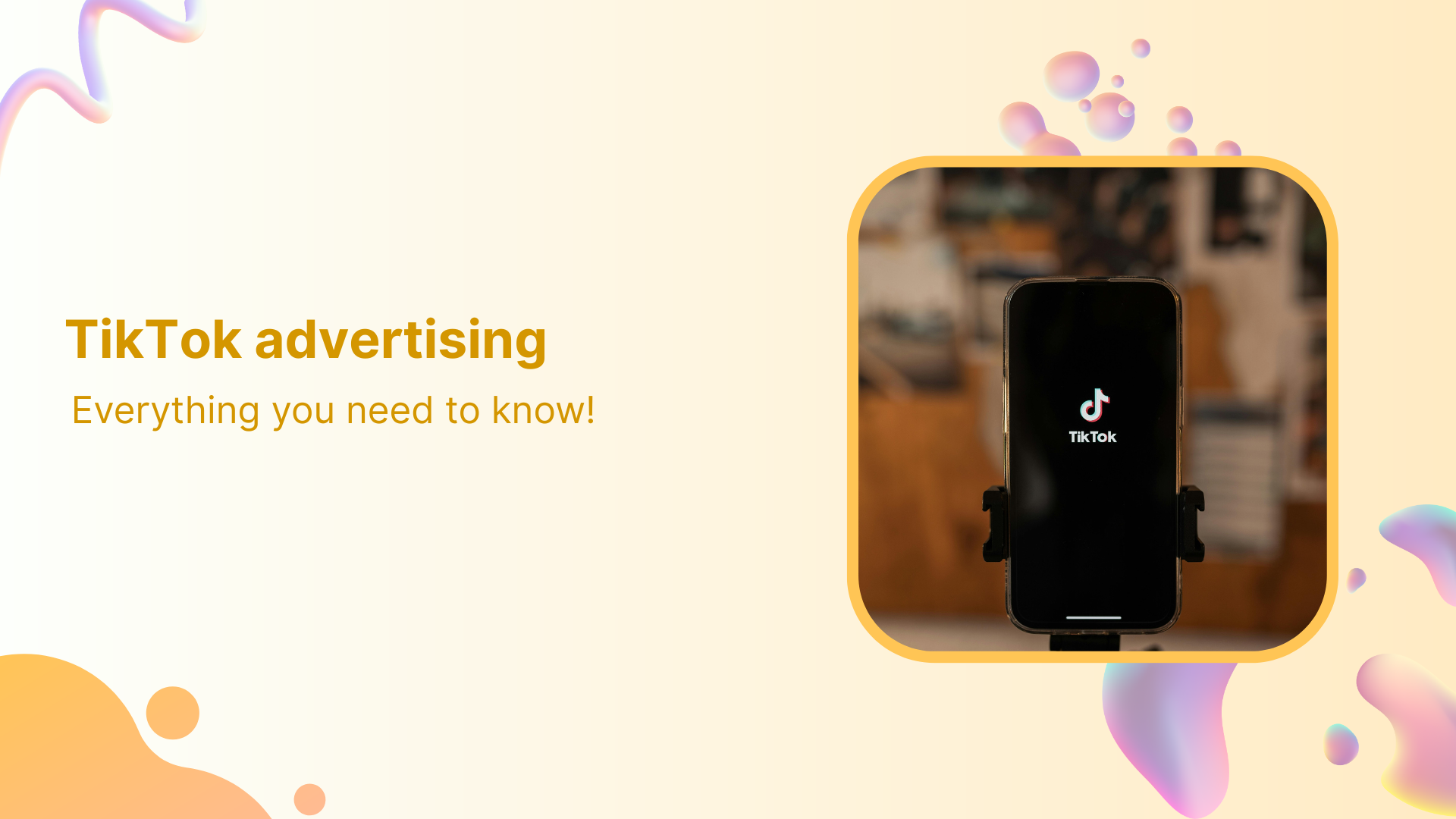TikTok has evolved from a dance-video app into a marketing powerhouse, boasting over 1.59 billion monthly active users worldwide. If you’re not advertising on TikTok in 2025, you’re missing out on one of the most engaged audiences in digital marketing.
But here’s the thing: TikTok advertising isn’t just about throwing money at trendy videos and hoping something sticks. It requires strategy, creativity, and a profound understanding of what drives the platform.
In this comprehensive guide, we’ll walk you through everything you need to know about TikTok advertising—from setting up your first campaign to scaling with a TikTok advertising agency. No matter if you’re running a small business or leading marketing at a Fortune 500, you’ll discover practical tips to boost your TikTok advertising skills.
Plan, schedule, share, and analyze content for 15+ social media channels.
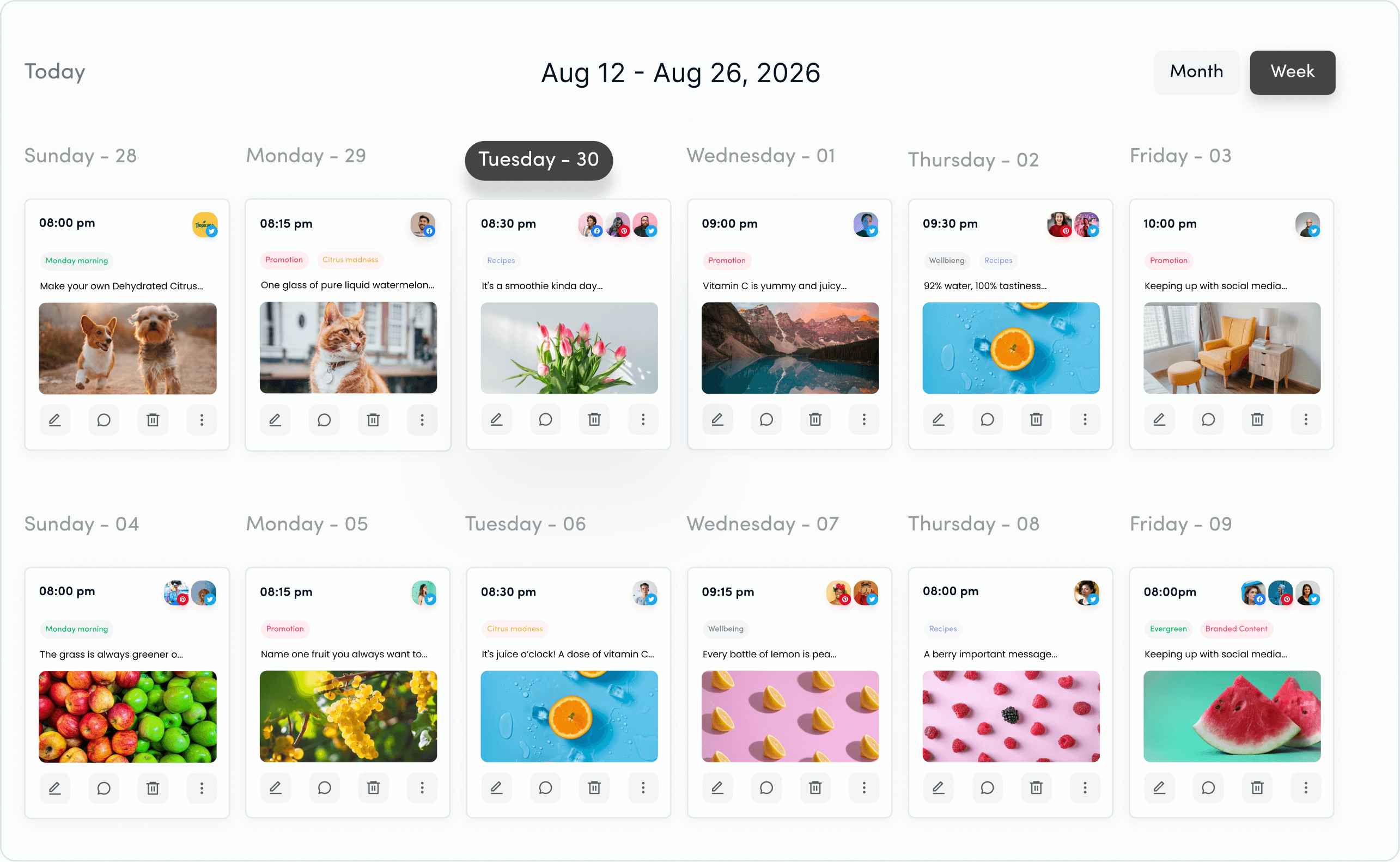
What is TikTok advertising?
TikTok advertising is the practice of promoting your brand, products, or services through paid placements on the TikTok platform. Unlike traditional social media ads that often feel intrusive, TikTok ads blend seamlessly with organic content, appearing as users scroll through their “For You” page.
What makes TikTok advertising unique is its algorithm-driven approach. The platform doesn’t just show ads based on demographics; it learns from user behavior, engagement patterns, and content preferences to deliver highly targeted advertisements that feel more like entertainment than promotion.
Understanding the platform in 2025
In 2025, TikTok introduced several exciting new features that have the potential to transform the way we connect and create content.
- Advanced AI-powered targeting that predicts purchase intent
- Integrated shopping experiences with TikTok Shop
- Enhanced analytics through TikTok Business Center
- Automated creative optimization tools
The platform’s advertising ecosystem has matured significantly, offering sophisticated tools that rival established players like Meta and Google while maintaining the authentic, creative spirit that made TikTok famous.
Why TikTok advertising matters for your business
The numbers don’t lie: TikTok’s explosive growth is undeniable. Consider these compelling statistics for 2025:
- Users spend an average of 53.8 minutes daily on TikTok
- 39% of users have purchased something they discovered on the platform
- The platform’s ad revenue is projected to surpass $32.4 billion in 2025
But it’s not just about reach—it’s about engagement. TikTok boasts an average engagement rate of 2.65%, which is 42 times higher than Facebook and 6 times higher than Instagram.
Real-world success story: Ocean Spray’s viral moment
Remember the Ocean Spray cranberry juice skateboarding video? Nathan Apodaca’s organic TikTok video sparked a marketing phenomenon. Ocean Spray quickly capitalized on this viral moment by:
- Creating their own TikTok account
- Launching Spark Ads using the original content
- Partnering with influencers for authentic promotion
- Running a branded hashtag challenge
The result? Ocean Spray saw a 20% increase in sales and gained over 100,000 TikTok followers in weeks. Their stock price jumped, and sales of cranberry juice across the industry increased by 15%.
TikTok vs. other social platforms: The competitive edge
When comparing advertising platforms in 2025, TikTok offers unique advantages:
- Cost efficiency: Average CPM on TikTok ranges from $4.20-$9.00, compared to Instagram’s $13.53
- Engagement rates: TikTok’s 2.65% average engagement dwarfs Facebook’s 0.06%
- Discovery potential: 64% of Gen Z use TikTok as a search engine
- Viral potential: TikTok’s algorithm favors content quality over follower count
Types of TikTok ads: Choosing the right format for your goals
From native in-feed videos that blend seamlessly with user content to premium TopView placements that ensure maximum visibility, TikTok offers a diverse range of ad formats to match every marketing objective and budget. Understanding each format’s strengths helps you invest wisely and achieve better ROI on your campaigns.
1. In-feed ads: Your bread and butter
In-feed ads are the workhorses of TikTok advertising. These 5-60 second videos appear naturally in users’ For You feeds, complete with all the interactive features of organic posts—likes, comments, shares, and follows.
- Best for: Direct response campaigns, app installs, website traffic
- Cost: $0.10-$0.30 CPC or $6-$10 CPM
- Pro tip: Keep them between 15 and 30 seconds for optimal engagement
Real example: Garanti BBVA Kripto’s in-feed ad demonstrates perfect native integration. The ad features a spokesperson in a professional yet approachable setting, using TikTok’s native features like:
- Live indicator to create urgency
- Clear CTA button (“Install now”) in brand colors
- Turkish language captions for the local market targeting
- Mobile-optimized vertical format
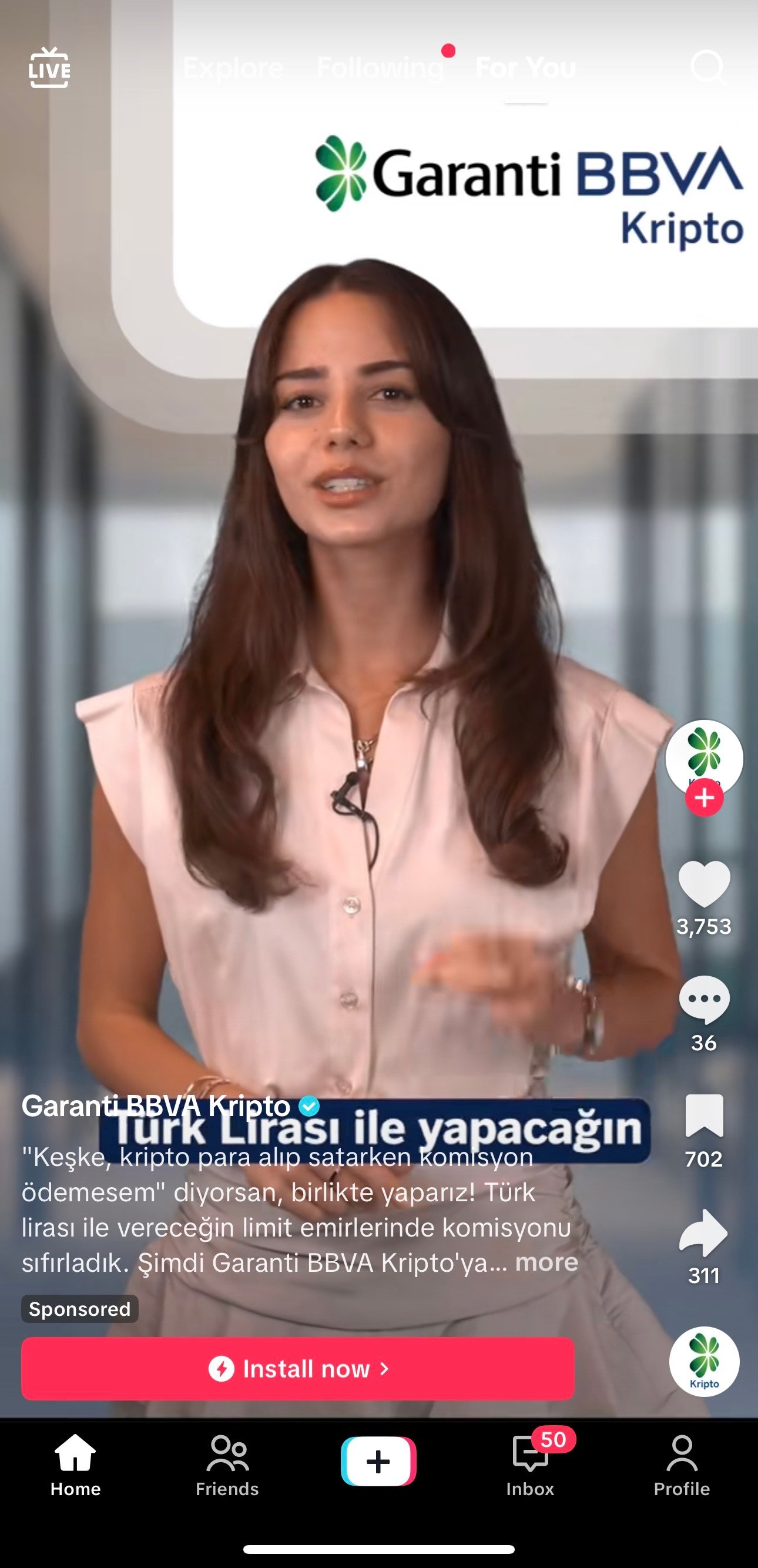
2. TopView ads: Making a grand entrance
TopView ads are premium placements that appear when users first open the TikTok app. You get three seconds of full-screen, sound-on video before it transitions to an in-feed format.
- Best for: Major product launches, brand awareness campaigns
- Cost: $50,000-$150,000 per day (varies by market)
- Pro tip: Reserve for high-impact moments like holiday campaigns
Real example: Turkish Airlines masterfully uses TopView ads to announce new routes with maximum impact. Their ad for the new Yanbu route (starting October 26) demonstrates premium placement effectiveness:
- Full-screen takeover with stunning destination imagery
- Premium brand positioning with iconic logo placement
- Strong CTA with “Shop” button for immediate booking
- Disclaimer text for transparency about campaign terms
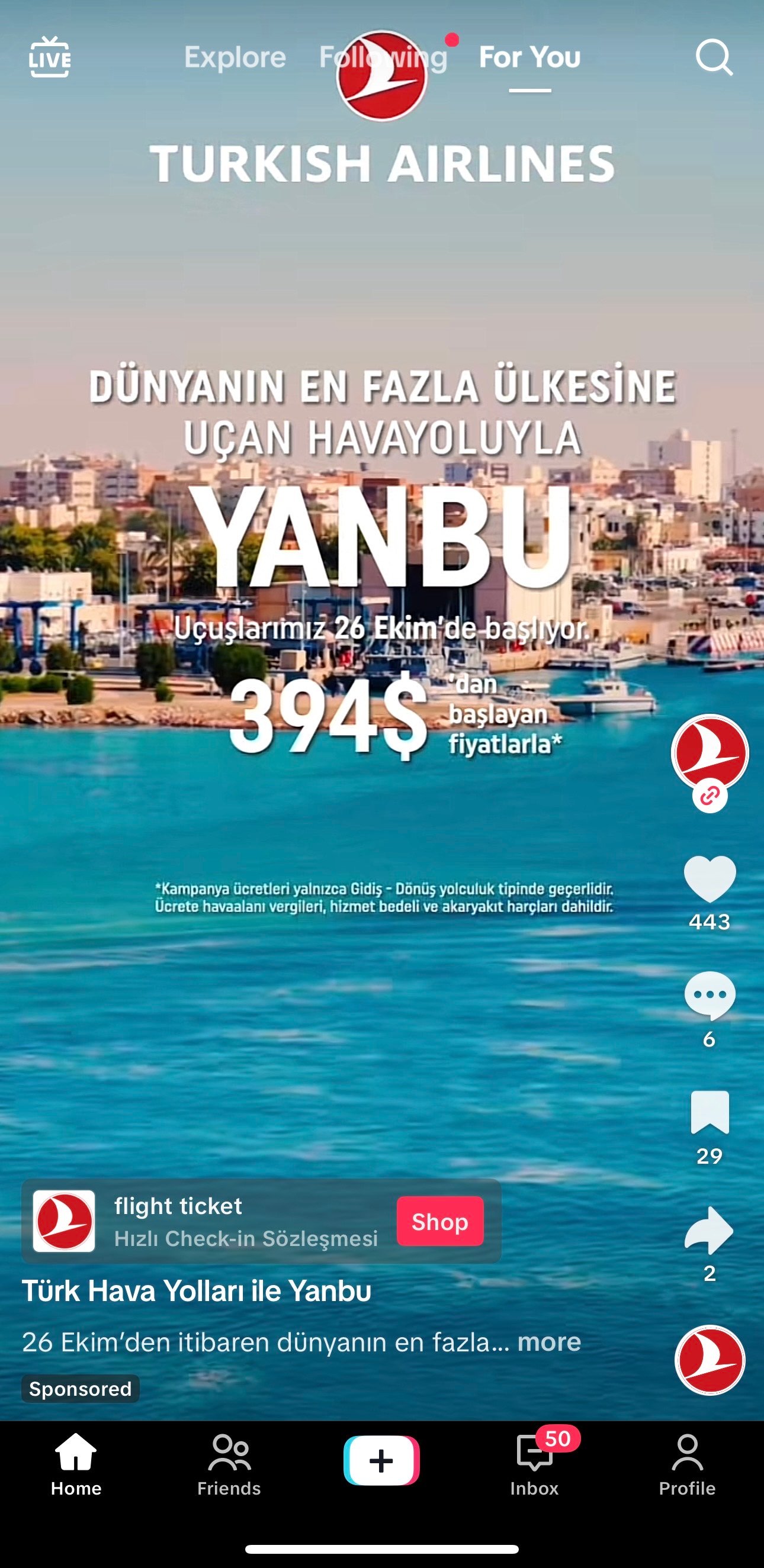
3. Spark ads: Amplifying authentic content
Spark ads let you boost organic posts, either your own or from creators who’ve given permission. These maintain all the original engagement metrics, making them feel incredibly authentic.
- Best for: Leveraging user-generated content, building social proof
- Cost: Similar to in-feed ads but with 30% higher completion rates
- Pro tip: Partner with micro-influencers for cost-effective Spark ad content
A real-world example: Adobe Lightroom’s Spark ad effectively demonstrates the power of leveraging user-generated content. The ad features creator @Wuzg00d showcasing fashion and lifestyle content while Adobe seamlessly integrates their “Generative Remove” feature promotion. Key elements that make this work:
- Authentic creator content (fashion/lifestyle post) as the primary visual
- Non-intrusive banner overlay with clear value proposition (“Poof, it’s gone with Generative Remove”)
- Strong CTA button (“Learn more”) that doesn’t disrupt the viewing experience
- The ad feels native because it IS native—real creator content with subtle brand messaging
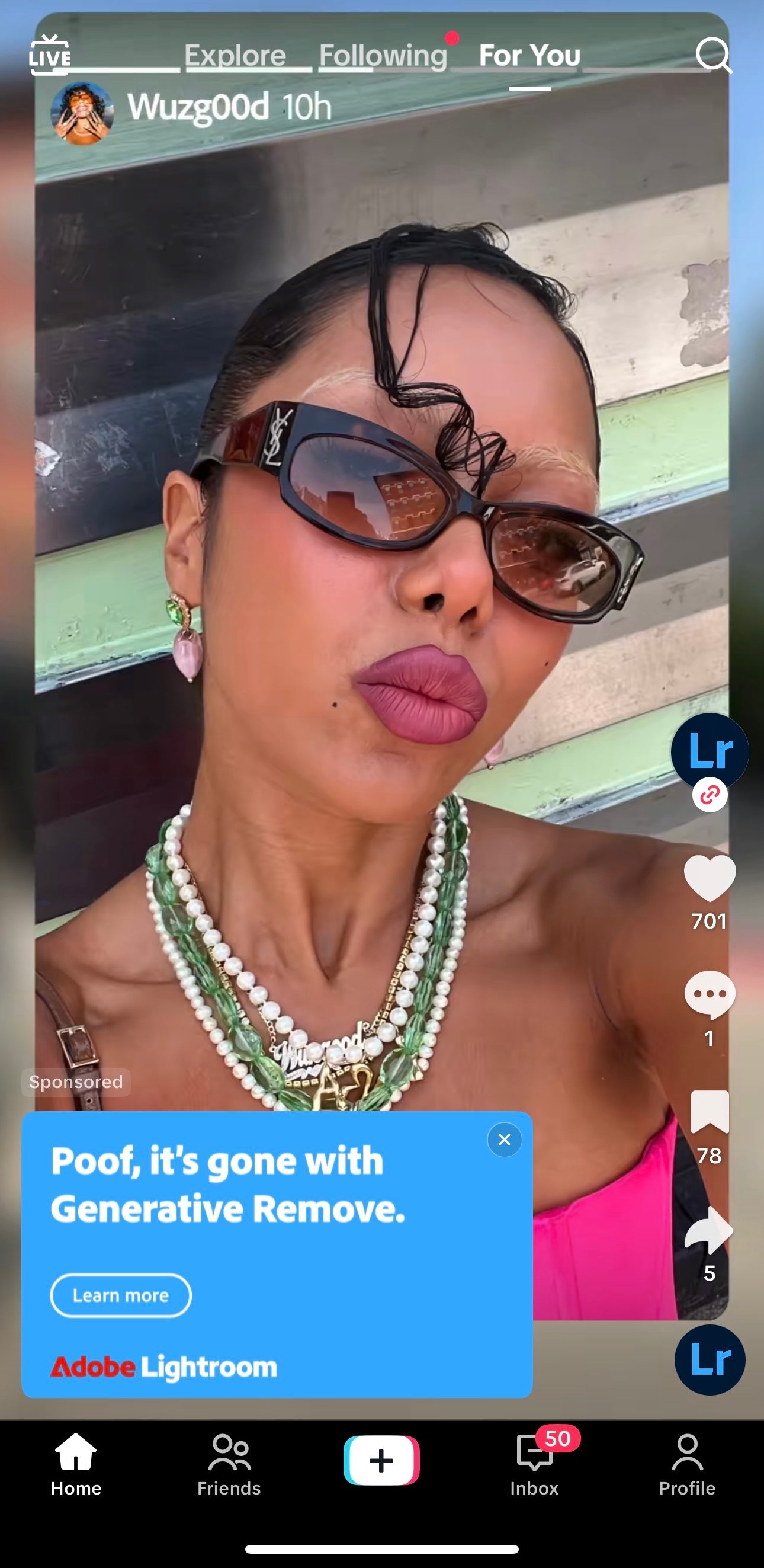
4. Branded hashtag challenges: Creating movements
These campaigns encourage users to create content around your branded hashtag, turning customers into content creators.
- Best for: Viral marketing, user engagement, brand awareness
- Cost: Starts at $150,000 for six days
- Pro tip: Combine with influencer partnerships for maximum reach
Real example: Chipotle’s #GuacDance challenge generated 250,000 video submissions and 430 million video starts in just six days, leading to their biggest guacamole day ever.
5. Shopping ads: The e-commerce revolution
TikTok’s shopping ads include Video Shopping Ads, Catalog Listing Ads, and LIVE Shopping Ads, creating seamless purchase experiences within the app.
- Best for: E-commerce brands, product discovery, impulse purchases
- Cost: Similar to in-feed ads with higher conversion rates
- Pro tip: Use dynamic product ads to showcase relevant items automatically
Real example: Sephora’s Video Shopping Ad demonstrates the perfect blend of content and commerce. Personalized & Renewed App Experience) showcases multiple beauty products in one frame:
- Features Rare Beauty, Waterproof makeup remover, and The Ordinary products arranged aesthetically
- Seamlessly promotes the Sephora app with a native TikTok-style CTA banner
- “Open” button leads directly to App Store download
- Users can either explore products shown or download the app for full catalog access
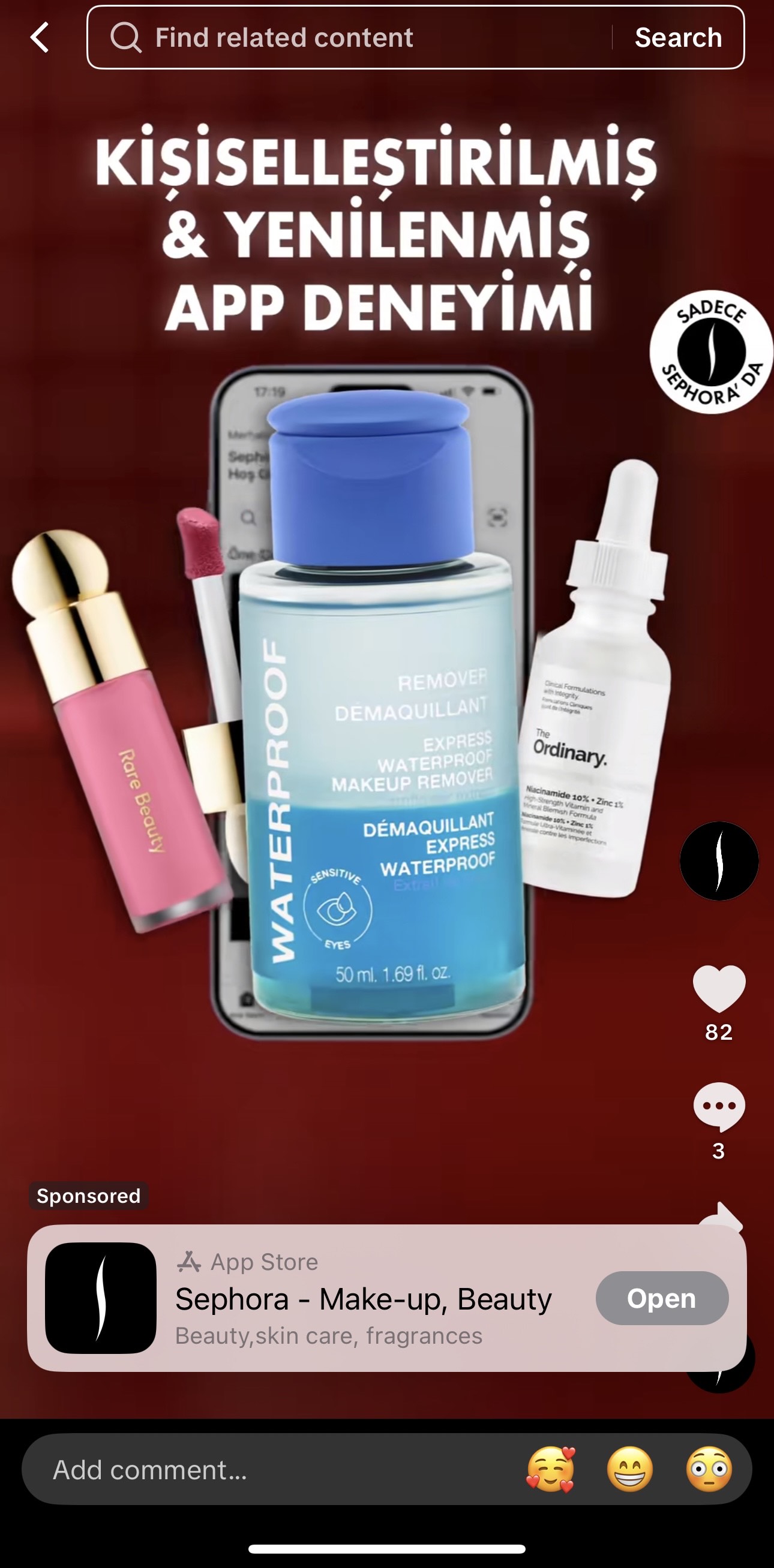
6. Carousel ads: Showcasing product collections
Carousel ads allow users to swipe through multiple images or videos in a single ad, making them ideal for showcasing product ranges or telling sequential stories.
- Best for: E-commerce catalogs, product collections, step-by-step tutorials
- Cost: Similar to in-feed ads with higher engagement rates
- Pro tip: Use high-quality product shots and ensure each slide can stand alone
Real example: Sephora’s carousel ad for Gucci Flora Gorgeous Orchid perfume shows sophisticated product marketing on TikTok. The ad features:
- Clean, professional product photography against a dark background for maximum visual impact
- Multiple slides (indicated by dots at the bottom) allow viewers to explore different angles or related products
- Prominent product name and description overlay
- Clear brand identification with both Sephora and Gucci branding
- Swipeable format that encourages interaction and extended viewing time
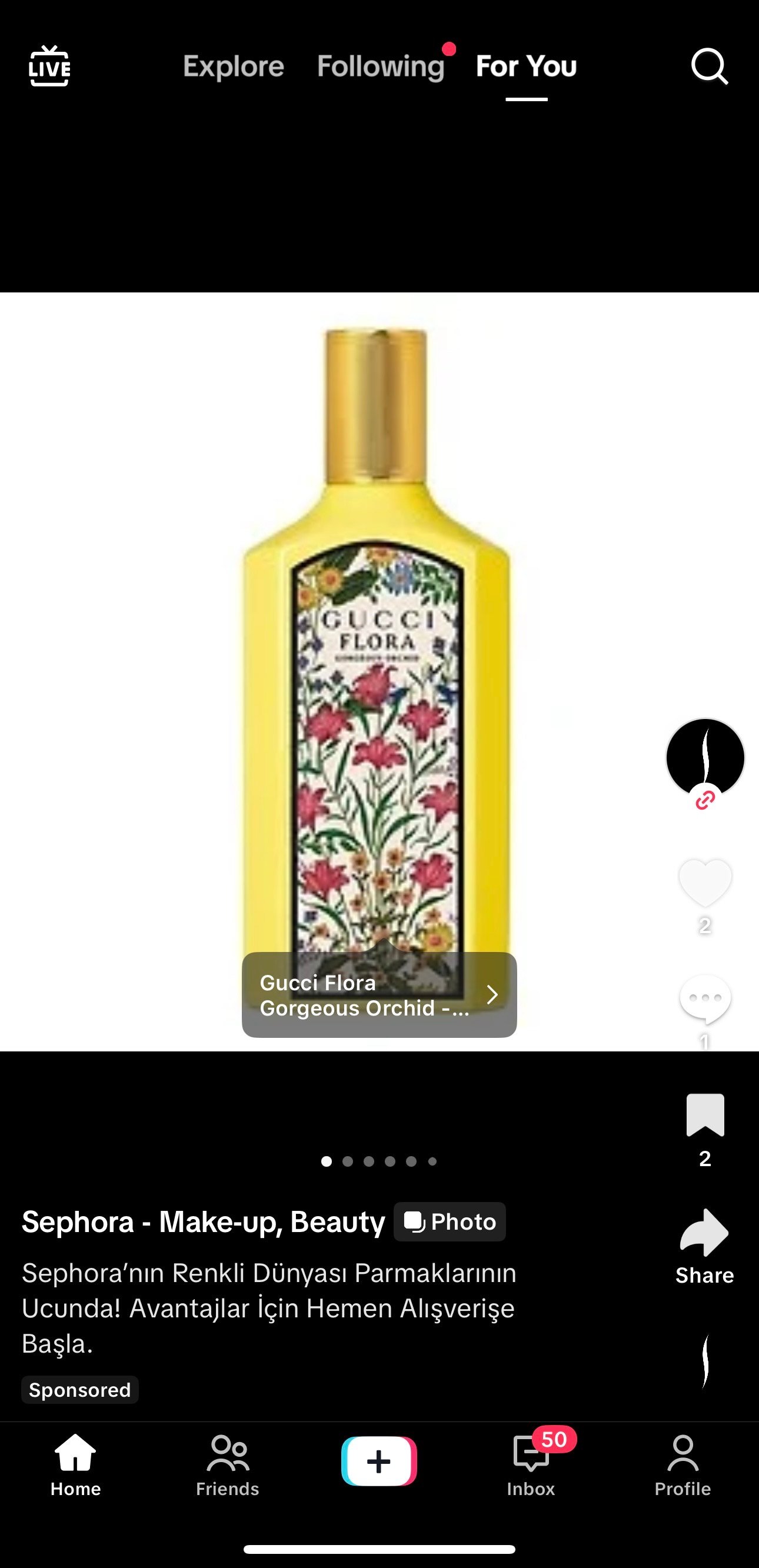
Step-by-step guide: Creating your first TikTok ad campaign
Setting up your first TikTok ad campaign doesn’t have to be intimidating—with the right roadmap, you can launch professional ads in under an hour. This step-by-step guide walks you through every click, from account creation to campaign launch, ensuring you avoid common pitfalls that waste budget.
Step 1: Set up your TikTok business account
Navigate to ads.tiktok.com and create your business account. You’ll need:
- Business name and industry
- Business registration number
- Payment information
- Website URL for verification
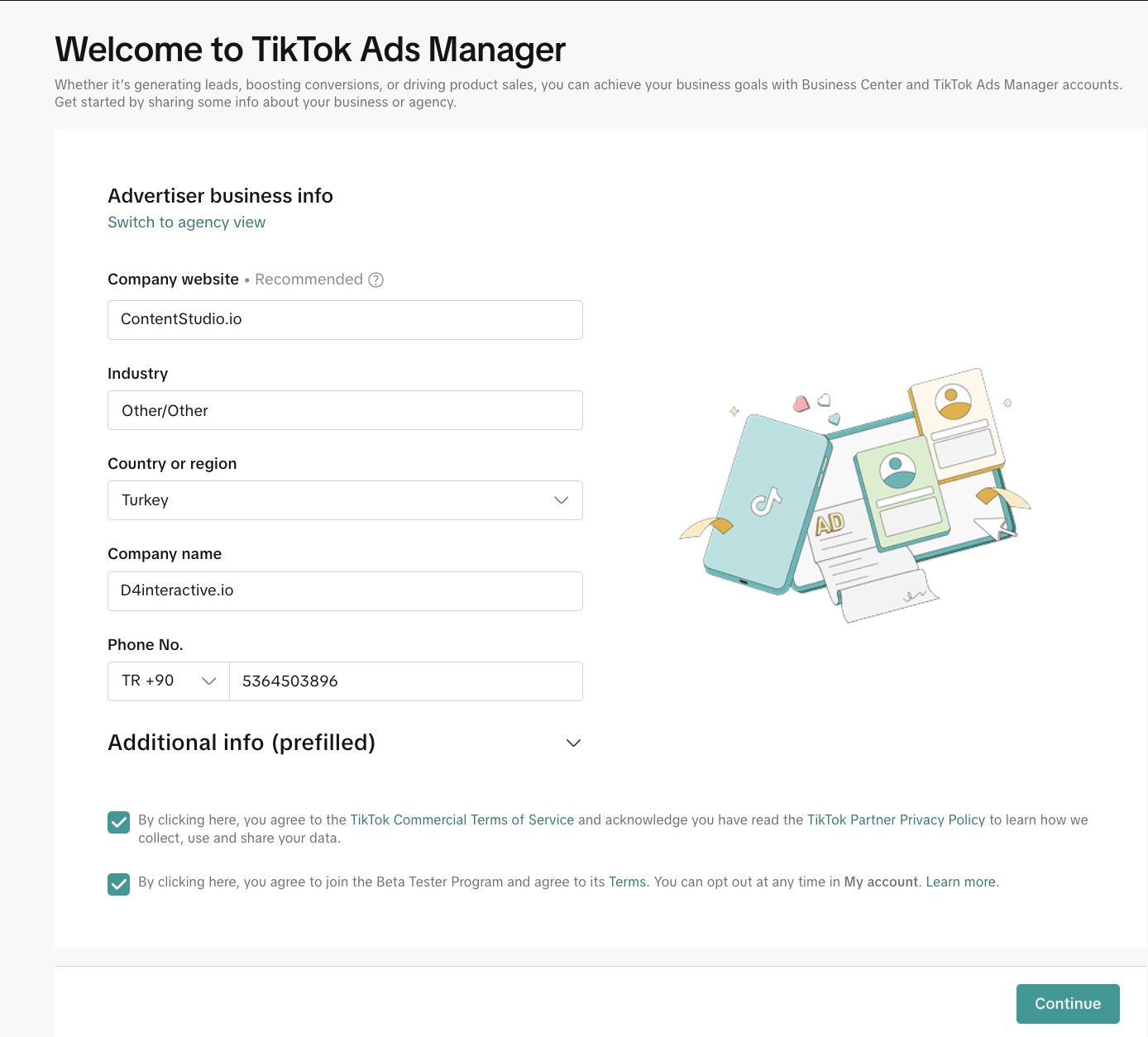
Step 2: Choose your campaign objective
Select from awareness, consideration, or conversion objectives:
- Awareness: Traffic, community interaction, video views
- Sales: Website conversions, Tiktok shop
- Lead generation: Website form, Tiktok instant form, Direct message, or phone calls
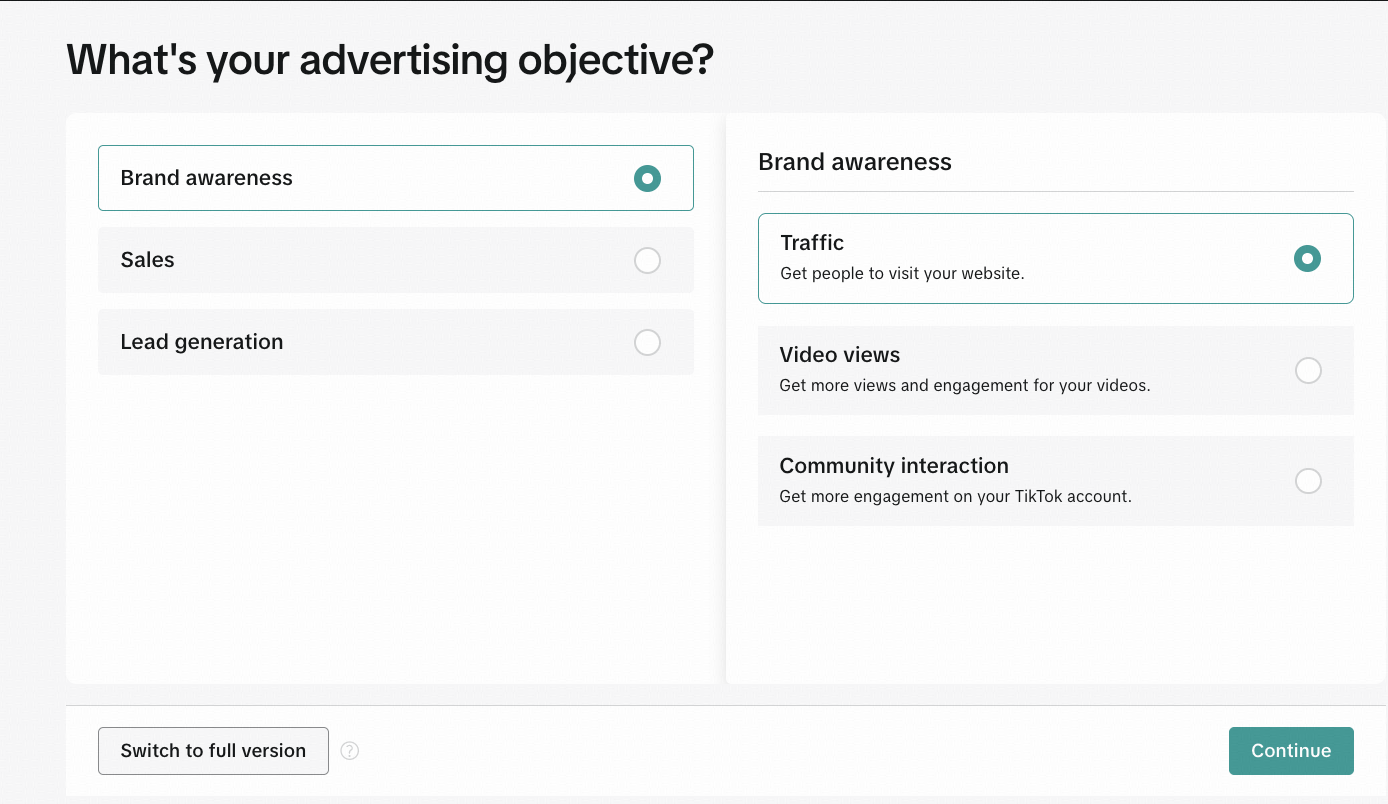
Step 4: Choose your campaign objective
As shown in the TikTok Ads Manager interface:
- Campaign name: Give your campaign a descriptive name (e.g., “Traffic) that includes the date and objective for easy tracking
- Optimization goal: Select from the dropdown menu:
- Landing page view: Best for driving quality traffic to your website
- Click: Optimizes for maximum clicks to your ad, regardless of quality
2. Placement Options: TikTok offers three placement strategies:
- TikTok includes search results: Your ads appear in both the For You feed and TikTok search results
- User comment (Recommended):
- Toggle ON to keep user comments enabled
- The platform notes: “We recommend keeping user comments on to help your ads achieve more impressions and conversions.”
- User engagement through comments helps with algorithm ranking
- Shows social proof and authenticity
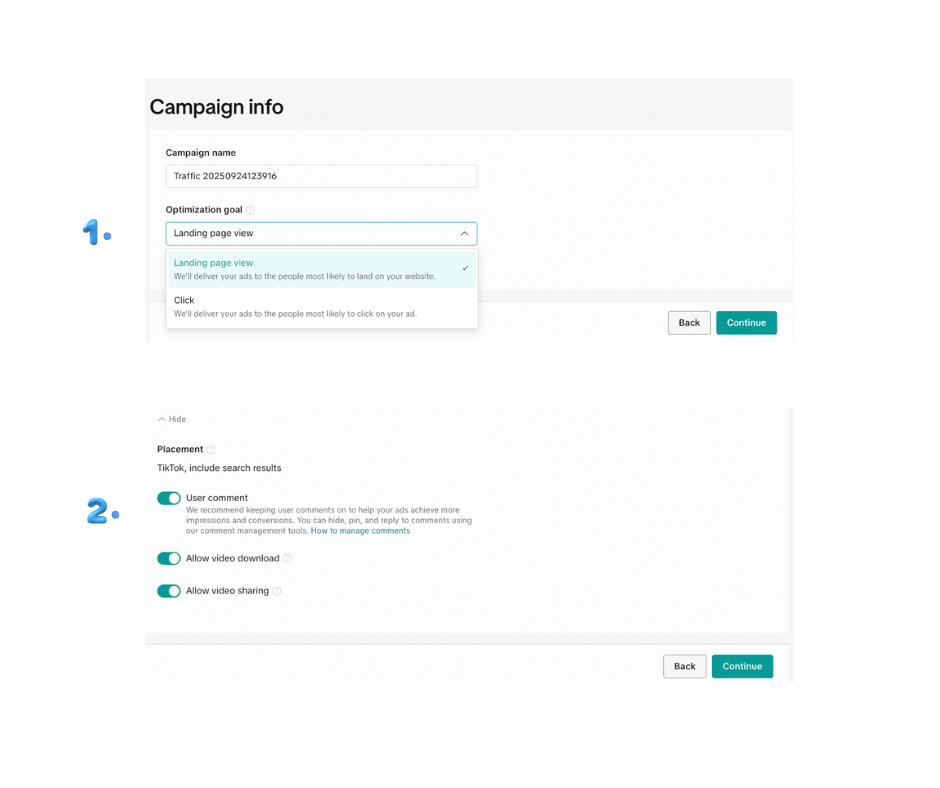
Step 5: Set your budget and schedule
- Start with $50-100 daily for testing
- Run ads continuously for algorithm learning
- Schedule for peak engagement times (6-10 am, 7-11 pm)
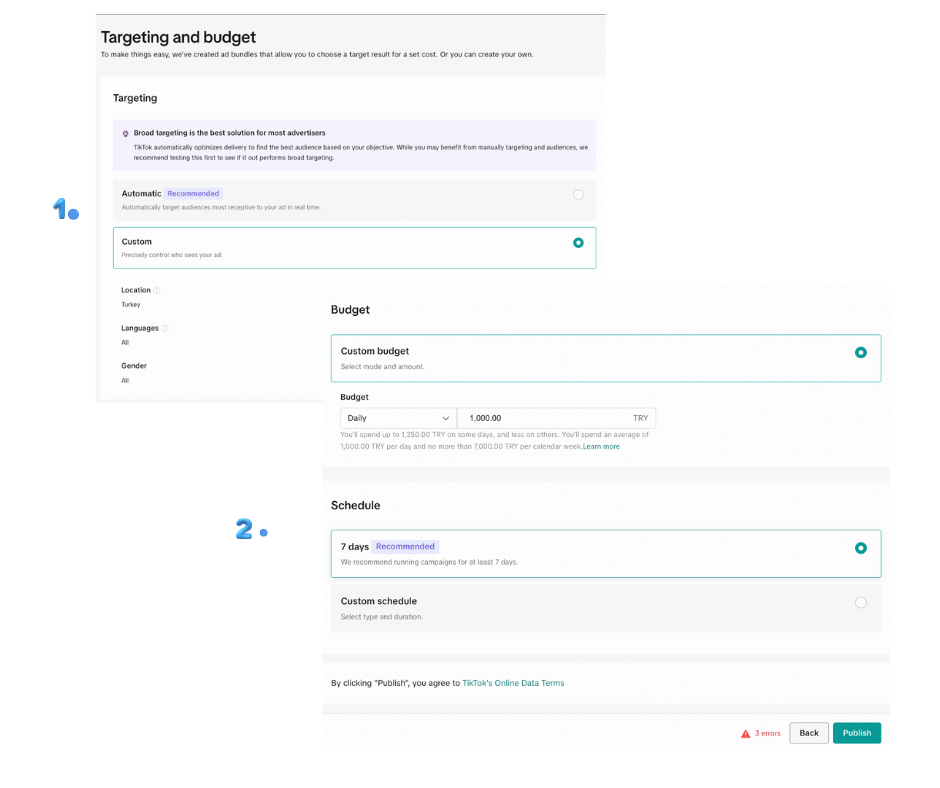
Step 6: Create compelling creative
Connecting your account enables you to turn your TikTok posts into ads. Uploading new videos or images through your TikTok account can enhance your ad performance. Follow the AIDA framework:
- Attention: Hook viewers in 3 seconds
- Interest: Show your product in action
- Desire: Highlight benefits and social proof
- Action: Clear CTA with urgency
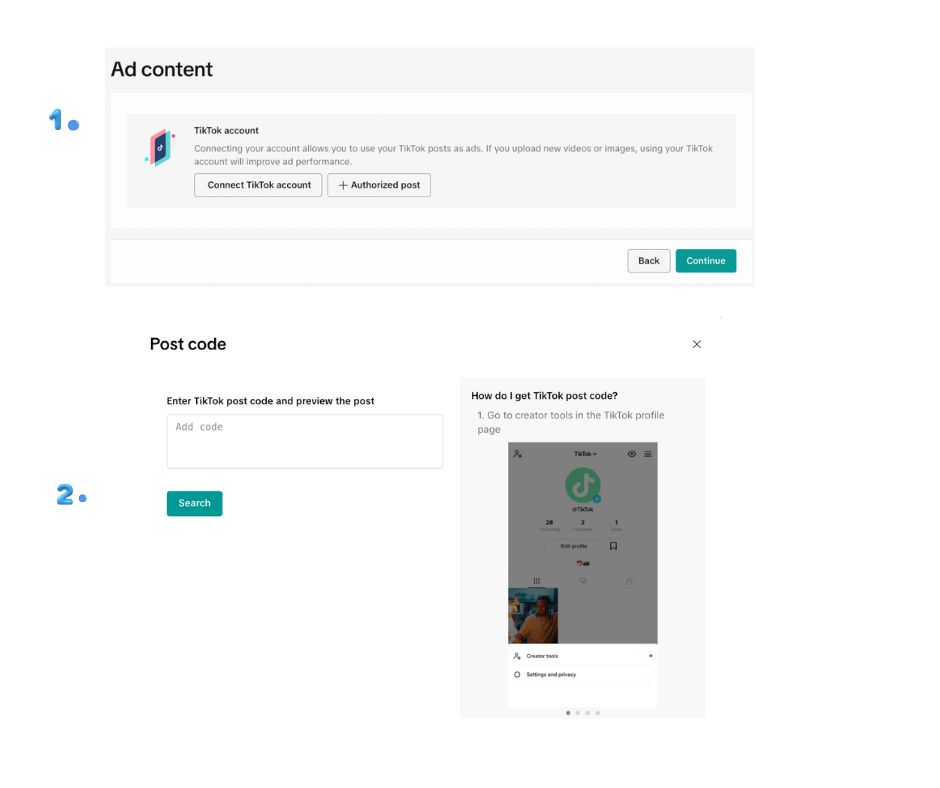
Step 7: Launch and optimize
- Monitor performance after 50 conversions
- A/B test different hooks weekly
- Scale winning ads gradually (20-30% budget increases)
6 best practices to build a TikTok ad strategy
Building a successful TikTok ad strategy doesn’t happen overnight. Here are six proven practices that top-performing brands use to dominate the platform:
1. Start with organic content, then amplify
Before spending a dollar on ads, understand what resonates organically. Post regular content for 2-4 weeks to identify which videos get the most engagement. Then turn your top performers into Spark ads.
Example: Fashion Nova posts 5-10 organic TikToks daily. They track which ones go viral, then immediately boost them as Spark ads. This approach provides them with pre-validated content, resulting in a 40% lower CPA compared to creating ads from scratch.
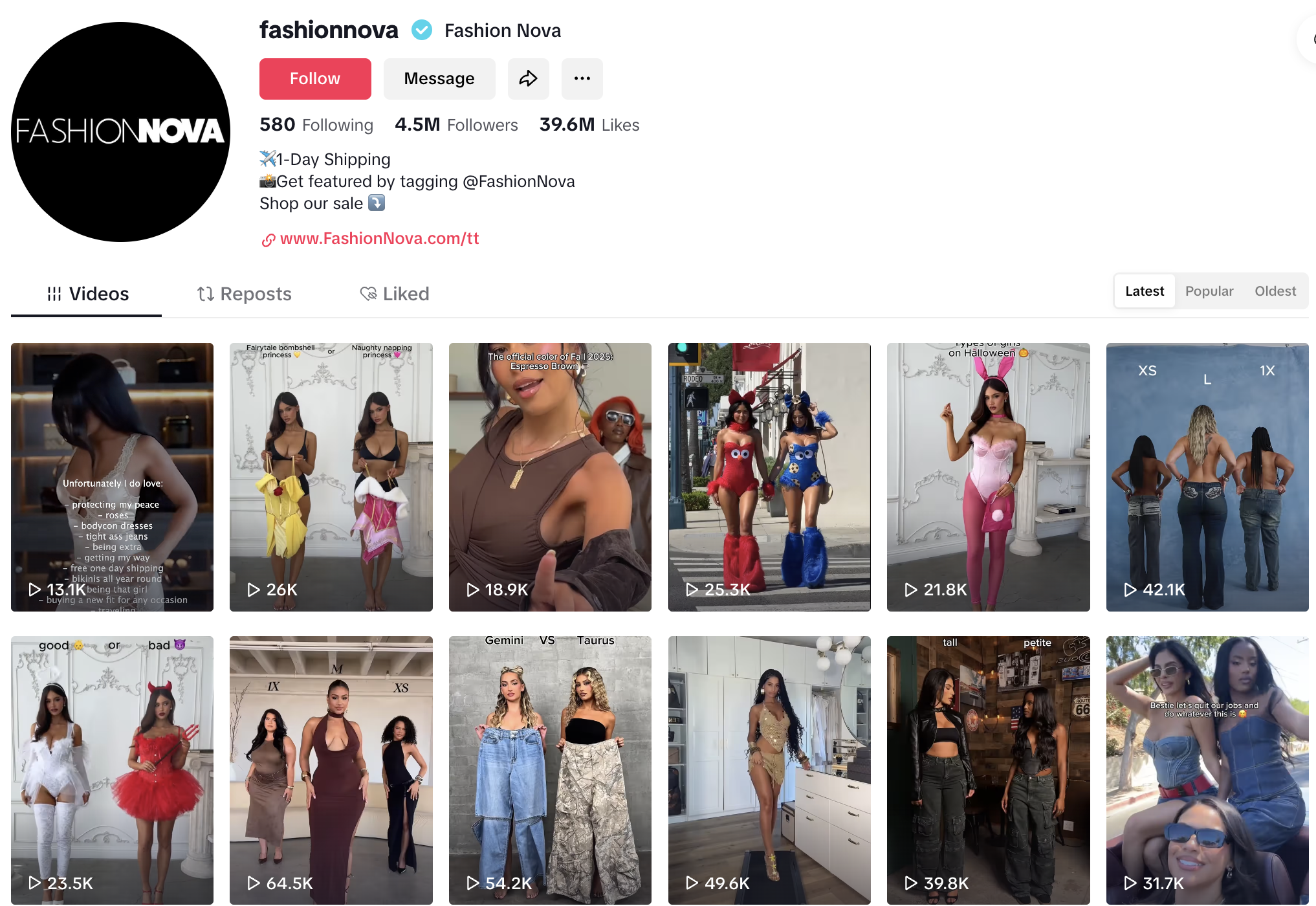
2. Create content specifically for TikTok (not recycled from other platforms)
Your Instagram Reels won’t work here. TikTok users can easily identify recycled content. Create TikTok-first content using:
- Platform-specific features (effects, filters, sounds)
- Vertical format without watermarks
- TikTok’s editing style and pacing
- Trending audio and hashtags unique to TikTok
Pro tip: If you must repurpose content, re-edit it completely using TikTok’s native tools.
Related: Simplify your TikTok hashtag contest with ContentStudio’s handy hashtag tool!
3. Test multiple creative angles simultaneously
Don’t put all your eggs in one creative basket. Launch campaigns with at least 3-5 different angles:
- Problem/solution approach
- User testimonial style
- Behind-the-scenes content
- Tutorial or how-to format
- Entertainment-first with soft sell
Real data: Brands testing 5+ creative variations see 2.3x better ROAS than those using single creative approaches.
4. Partner with creators at every level
Build a creator ecosystem with:
- Nano-influencers (1K-10K followers): High authenticity, low cost
- Micro-influencers (10K-100K): Best engagement rates
- Macro-influencers (100K-1M): Broader reach
- Mega-influencers (1M+): Maximum visibility
Innovative approach: Allocate 60% of the budget to micro-influencers, 30% to nano-influencers, and 10% to macro/mega-influencers for optimal ROI.
5. Optimize for TikTok’s unique buying journey
TikTok users don’t follow traditional marketing funnels. They discover, research, and buy all within the app. Structure your strategy accordingly:
- Discovery phase: Entertaining content that doesn’t feel like ads
- Interest phase: Educational content showing product benefits
- Purchase phase: Social proof and limited-time offers
- Loyalty phase: User-generated content and community building
6. Use data to inform creativity (not replace it)
While data is crucial, don’t let metrics kill creativity. Use a 70-20-10 approach:
- 70% proven concepts: Scale what’s working
- 20% iterations: Tweak successful ads with new hooks or CTAs
- 10% wild cards: Test completely new, creative ideas
Remember: TikTok’s biggest successes often come from unexpected creative risks that data would never have predicted.
Conclusion:
TikTok advertising in 2025 isn’t just an option—it’s essential for brands targeting younger demographics or seeking viral growth. The platform’s unique combination of entertainment, commerce, and community creates opportunities that are not found elsewhere.
Remember: TikTok rewards creativity over budget. A clever $500 campaign can outperform a boring $50,000 one. Focus on authentic storytelling, embrace the platform’s culture, and don’t be afraid to take creative risks. The brands winning on TikTok in 2025 aren’t the ones with the biggest budgets. They’re the ones brave enough to stop advertising and start entertaining.
FAQ’s
How much does TikTok advertising cost in 2025?
TikTok advertising begins with a minimum campaign budget of $500 or $50 per day. The average CPM ranges from $4.20 to $9.00, while the CPC typically falls between $0.17 and $1.00. Most small businesses should allocate $1,000 to $3,000 per month for effective testing and optimization.
Is TikTok advertising worth it for small businesses?
Yes, TikTok advertising can be highly effective for small businesses, especially those targeting Gen Z and Millennials. With 39% of users making purchases discovered on TikTok and engagement rates 42x higher than Facebook, even modest budgets can generate significant ROI when combined with creative, authentic content.
What’s the best TikTok ad format for beginners?
In-feed ads are the best starting point for beginners. They’re cost-effective, blend naturally with organic content, and allow for full engagement features. Start with in-feed ads to test your creative and audience before investing in premium formats, such as TopView or Branded Hashtag Challenges.
What’s the biggest mistake brands make with TikTok ads?
The biggest mistake is creating ads that feel like traditional commercials. Over-polished, sales-heavy content fails on TikTok. Instead, embrace authentic, mobile-shot videos with native features, trending sounds, and genuine storytelling. Remember: make TikToks, not ads.
What are TikTok advertising services?
TikTok advertising services are professional agencies or consultants specializing in TikTok campaign management. They offer creative production, campaign strategy, audience targeting, optimization, and reporting. Services range from full-service management to specialized offerings, including creative production and audit consultations.
